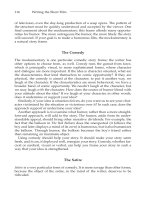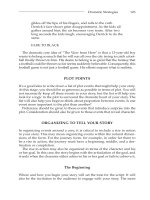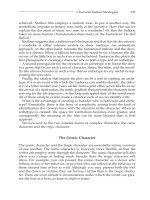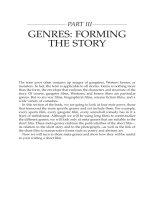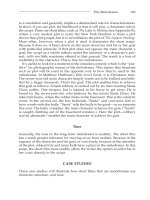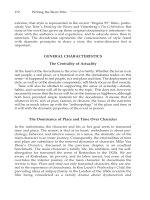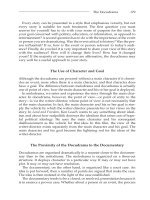Tài liệu Writing the short film 3th - Part 31 pptx
Bạn đang xem bản rút gọn của tài liệu. Xem và tải ngay bản đầy đủ của tài liệu tại đây (123.04 KB, 7 trang )
Style in the Short Film
There is simplicity in a moral tale. All elements—character, plot, and tone—
put the unfolding of a narrative in the service of the moral. Metaphor, exag-
geration, unnatural events and characters can all be brought to bear on the
moral purpose of the story. Even a filmmaker as grounded in realism as
Bergman found in The Seventh Seal (1956), for example, that he had to move
away from realism. The moral tale—no man can escape mortality—is his
subject, and so death and a plot specifically about the spread of Bubonic
Plague, the “Black Death,” are his instruments.
The purpose of the narrative, a moral tale, dictates an imaginative, non-
naturalistic treatment of the subject. This is the first observation we can
make about hyperdrama and the short film.
The Main Character and His or Her Goal
As in the long film, the main character and his or her goal serve the moral
rather than inviting identification. The character tends to be a vehicle,
even in stories where he becomes a superhero (Star Wars). The voice of
the writer-director, his or her affiliation to the moral rather than to the
character, distances us from character. Nevertheless, the main character
does have a well-defined goal, and it carries him or her forward into the
narrative.
The Role of Plot
Plot is very important in hyperdrama. It provides the scale of the story.
Unlike in other genres, it is critical to the success of the narrative. In the
short film, the plot will have far more effect than character. The resulting
sketchiness of the characters helps the metaphorical presentation of the
narrative.
The Structure
The first important element to the structure is the presence of a narrator,
someone who will tell the story. In Lisa Shapiro’s Another Story, it is the
grandmother. In Juan Carlos Martinez-Zaldivar’s The Story of a Red Rose, it is
a narrator-storyteller who is not visible but acts as the aural guide to the
story.
200 Writing the Short Film
Ch15.qxd 9/27/04 6:11 PM Page 200
A second observation about structure is that there is very rapid character-
ization, and the plot is introduced quickly. The plot is presented in the form
of a journey—a journey whose purpose is to illustrate the moral.
Tone
As in the long film, the tone is far from realistic and in fact is quite free—it
can be fantastic, or it can be very dark. In both cases, the tone has to make
credible events and characters that do not exist in our everyday lives. The
presentation of the material should sharpen the passion the author feels
regarding the moral tale that underlies the narrative.
A Case Study in Character
Lisa Shapiro’s Another Story, reprinted in Appendix B, is a cautionary tale
about individual differences and how those in power treat those who are dif-
ferent. A grandmother tells a story to her two granddaughters. In an unde-
fined place in the past, there are two young girls (the age of the two hearers
of their grandmother’s story). The period seems medieval. The small girls do
not like wearing mittens over their black fingernails. One day they are
arrested by the knights of the king—because they have black fingernails.
They are imprisoned. In prison, one sister saves the other. The story ends
with the epilogue: the evil king is overthrown and those with black finger-
nails no longer have to be afraid. Back in the present, the question is asked
whether the story is real and where the grandmother heard it. The film ends
with an image of the concentration camp numbers tattooed onto the grand-
mother’s arm; we realize that the story was a fable based on her Holocaust
experience.
The characterizations here are simple: the grandmother and the two girls
are the principals. There are knights and parents, but all of their characteri-
zations remain on the level of symbol. The grandmother exudes warmth,
and the children exude energy and curiosity. Beyond that, everyone is a sym-
bol serving the plot.
Case Study in the Role of the Antagonist
Dead Letters Don’t Die, by Anais Granofsky and Michael Swanhaus, is a mod-
ern fable about hope and hopelessness. The main character, a postal worker,
is always hopeful. His boss, the woman he loves from her letters, and the
The Hyperdrama 201
Ch15.qxd 9/27/04 6:11 PM Page 201
Santa Claus character all represent urban cynicism. They fulfill the role of
antagonist, not in the sense that the main character hates them, but rather in
terms of the social and psychological attitude they represent. They have
given up hope. The plot, the effort to save the world by throwing money
from the top of the Empire State Building, is not a success. So Fupper’s con-
version of Amanda, the effort to rescue her, to offer her his love, becomes his
offer of hope. To save one person without hope is to save the world. This is
the moral of the Granofsky/Swanhaus screenplay. It is unusual in that we
care about the fate of those who represent hopelessness, the antagonists in
the narrative.
Case Study in Plot and Tone
Juan Carlos Martinez-Zaldivar’s The Story of the Red Rose is based on a fairy
tale by Oscar Wilde. Every effort is made to be faithful to the fairy tale. This
is the story of how red roses came to be, and it depends on the interplay of
humans with creatures who are partially human, partially nymphlike, called
“nighting birds.” The time is the distant past. A scientific human pursues the
Infanta (princess). She asks of him a red rose to match her dress at the ball
where they will dance together (if her request is met). But red roses do not
exist. She has set him an impossible task.
He captures a female nighting bird, Sirah, and kills another, a male. He
studies them anatomically. Rather than sacrifice the female nighting bird, he
frees her. She loves him for it and tries to be more human, but he is con-
sumed by the Infanta.
Sirah approaches first the yellow rose bush and then the white rose bush
in her quest to create a red rose. The white rose bush tells her that there is
only one way. It gives her a white rose that she must plunge deep into her
heart, and her blood will dye the white rose red. The white rose bush asks if
it is for a human. She acknowledges it and sacrifices her life to create the
necessary rose.
The human finds the rose and her body. He buries her. He rushes with the
rose to the Infanta, but he is rebuffed. Someone else has offered her rubies.
The scientist is crushed, but red roses grow from Sirah’s grave, and this is
how red roses began to grow.
The plot of The Story of the Red Rose is Sirah’s search for a way to create
a red rose. It involves a journey that leads her from love to self-sacrifice
and death. The moral is implied that only through self-sacrifice and love
can true beauty (the red rose) be created. As we expect in hyperdrama, the
plot far outweighs the characterizations of Sirah, the scientist-human, and
the Infanta.
202 Writing the Short Film
Ch15.qxd 9/27/04 6:11 PM Page 202
In terms of tone, this fairy tale is marked by beauty, violence, grace, and
sacrifice. Its characters are paradoxical—the humans are not graceful, but the
half-humans (the nighting birds) and the white bush are honest and filled
with grace. Naturalness is nowhere to be seen. A formal, ritualistic quality
shapes the nonnaturalistic tone and fills the story with beauty and horror, as
suits the moral.
Hyperdrama requires such excess to assure the foregrounding of the
moral (the voice of the author) over any identification with the character in
the narrative.
NOTES
1. J. Campbell, Hero With 1000 Faces (New York: World, 1965).
2. Mad Max, Road Warrior, Beyond Thunderdome.
The Hyperdrama 203
Ch15.qxd 9/27/04 6:11 PM Page 203
Ch15.qxd 9/27/04 6:11 PM Page 204
